SELECT m.*, META(m).id
FROM boothduty m
WHERE m.type = 'mongodbcomparison'
ORDER BY UUID()
LIMIT 1;Posts tagged with 'C'
How are you liking Season 3 so far? I'm having a blast!
Some reminders:
The new original music is by JoeFerg. Check out his stuff!
Have you checked out my sponsor yet? Smartsheet!
If you're enjoying the new JavaScript game show, please start sending in your suggestions. I'm running out of ideas, and you and your ideas could be featured on this show. I need real and made-up suggestions!
Subscribe now!
Here's what's coming in February:
- Stephen Clearly on Azure Functions
- Scott Drake on hiring programmers
- Jeffrey Miller on Neo4j
- Andrea Cremes on SaaS
Subscribe now with your podcatcher of choice!
Want to be on the next episode? You can! All you need is the willingness to talk about something technical.
I’ve been using Crowdfire social media management tool on Android for a few months now, and I’ve been a paying customer for a while. So, I think it’s time to share my thoughts on it, and why you might want to give it a shot.
Disclaimer: a small promotional consideration was paid by Crowdfire for this post. But I probably would have written it anyway.
I work as a developer advocate, and a significant portion of that is using social media to promote, engage, build a follower base, etc. However, I have some problems:
-
I’m forgetful: I need to remember to help promote posts of my friends and coworkers
-
Scheduling: I’ve used Twuffer in the past (and I still occasionally do), but I’d like an easier way to schedule tweets on my phone.
-
Tracking: I’d like to track how my follower count is doing, and how well I’m sending out promotional tweets.
-
I don’t want my Twitter feed to only be a shill-broadcast of self-promotion. I use IFTTT for certain things, but I want to have some degree of control over what I post, the hashtags I use, the phrasing, etc.
There are a lot of tools out there for doing this, but many of them don’t solve all these problems (especially the last one).
I don’t remember where or how I found Crowdfire, but it’s now something that I use every day. Literally it’s one of the first things I do when I wake up in the morning.
It has a lot of capabilities, I’m only going to cover a few in this post.
What Crowdfire is not
It’s not a replacement for my Twitter client of choice. I still use the Twitter app to do all my reading and a bunch of my tweeting. If I turned over complete control of my Twitter/Facebook/etc account to an app like Crowdfire, IFTTT, etc, then I think I’d be missing the point of social media. I want to be a real person that people can talk to and not just an automated feed of links.
Daily Notification and "prescriptions"
Whenever a new post hits the Couchbase blog, I get a notification and prompt to share the post (whether I wrote the post or not). I also get a report every morning showing the number of followers and unfollowers since yesterday. This provides me daily feedback on whether I’m getting too annoying on social media or not. Also, when I share a post on Crowdfire, it will automatically schedule to tweet them up to 4 times over a 30 day period at the "best time" of day. I’m not sure how they calculate this, but it spaces out my tweets nicely, and I’ve found that repetition of tweets leads to more people seeing them and tweeting with me than before I used Crowdfire.
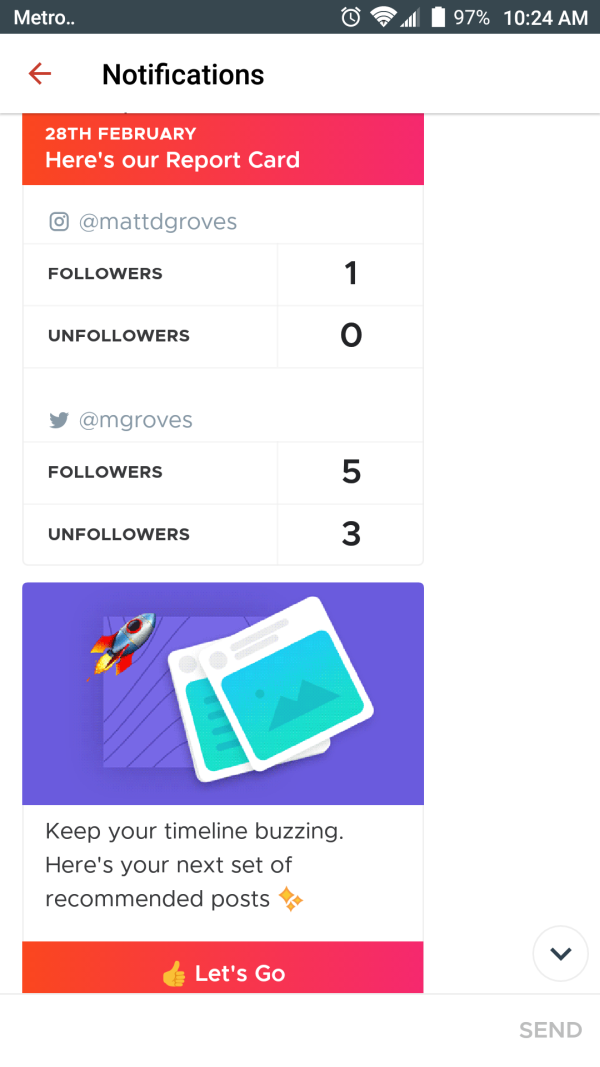
Scheduling
As I mentioned above, not only will Crowdfire remind me to tweet, it will also schedule tweets. Everyone uses Twitter at different times, so it’s helpful to send out multiple tweets (but not too many) to reach everyone that I can. In addition, I can manually schedule tweets. I find this helpful when promoting new podcast episodes.
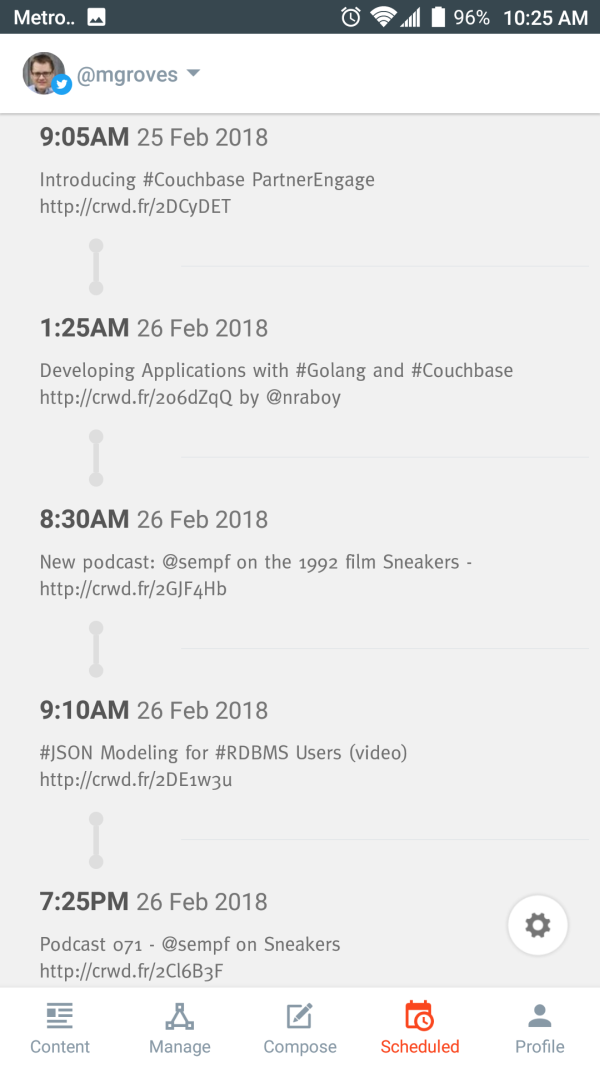
RSS Feeds
One feature that Crowdfire has introduced after I started using it, is the ability to connect to any RSS feed. Previously I was limited to just WordPress or other well-known engines. But now I can use Crowdfire with my own site’s RSS feed. This way I can track which posts I’ve promoted on Twitter and which ones I haven’t.
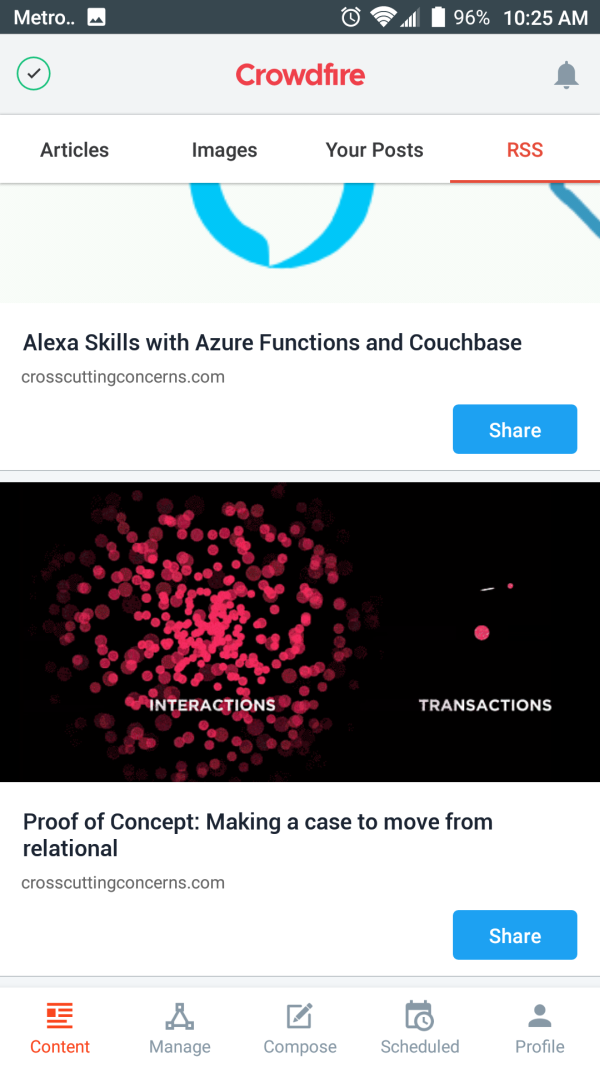
Recommended sharing and following
I’ve given Crowdfire some keywords that I find most relevant. It will then recommend people to follow or articles to tweet that are relevant to me. To me, Twitter isn’t just about getting a bunch of followers, but it’s about doing a lot of following.
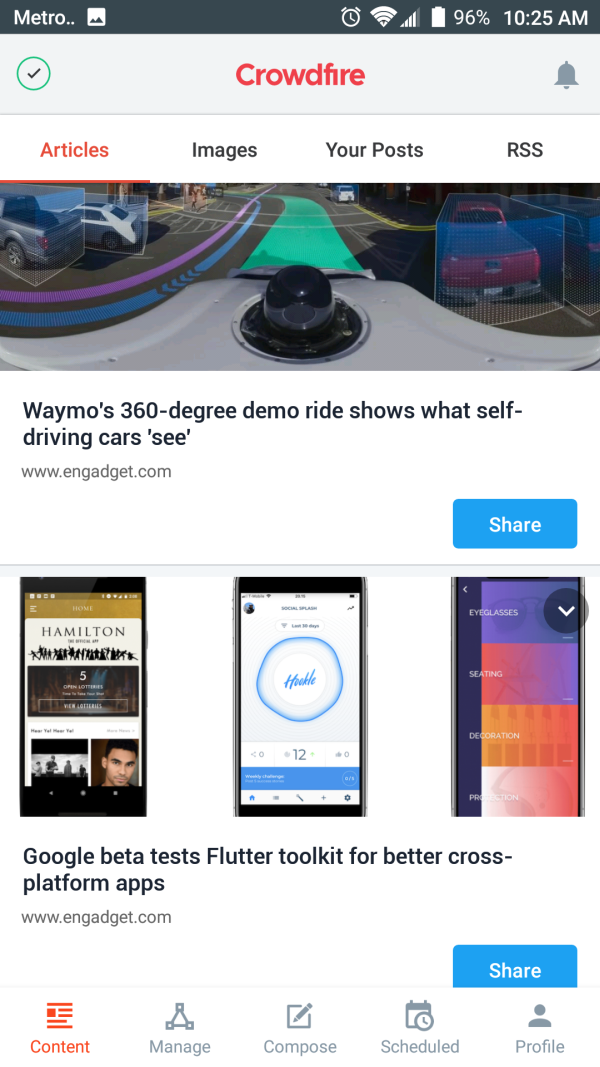
I usually find this helpful, but this is probably the area where I think Crowdfire could most improve. I get a few suggestions of people who don’t tweet in English, and articles that I’m not interested in, for instance.
Summary
Give Crowdfire a shot. They have a free version, which has some limits, but it’s absolutely enough to evaluate the tool and see if you find it useful. Crowdfire is in the Google Play store.
Bill Sempf and I watched a movie called Sneakers. This episode is sponsored by Smartsheet.
This is an extra-large, jumbo-sized, special episode of Cross Cutting Concerns. There's just too much awesome in Sneakers to fit in a 15 minute episode. But don't worry, I'll be back to regular length episodes starting next week!
Show Notes:
- Sneakers is a 1992 movie. If you haven't seen it yet, go watch it first, because this podcast contains spoilers! It's available to stream on Amazon, and it is well worth a purchase.
- Check out the incredible cast on IMDb (and also peek at the trivia section)
- An interview with Bob Abbott
- RSA - named after Rivest, Shamir, Adleman
- Intel's 49 qubit chip
- Fluhrer, Mantin, and Shamir attack on RC4
- Book: Brute Force: Cracking the Data Encryption Standard by Matt Curtin
- We mentioned: Dark Web, Deep Web, Tor, look it up
- OSINT Framework by Justin Nordine
- Blue Team vs Red Team
- Conferences: CodeMash, DerbyCon
- David Kennedy segment on CNN Money
- Podcast: Security Through Education - Episode 098: Winning the SECTF with Chris & Rachel
- The Economist cover and story: The world’s most valuable resource is no longer oil, but data
- Bitcoin was mentioned
- Paper: Smartphone User Identity Verification Using Gait Characteristics (gait analysis)
- Comic: XKCD on Security
- Captain Crunch = John Draper, here's a video from ABC News
- Tiger Team: Car Dealer Takedown
- OWASP
Want to be on the next episode? You can! All you need is the willingness to talk about something technical.
Music is by Joe Ferg, check out more music on JoeFerg.com!
This is a repost that originally appeared on the Couchbase Blog: Alexa Skills with Azure Functions and Couchbase.
Alexa Skills are the "apps" that you can build to run on Amazon devices like the Echo, Echo Dot, etc. In this blog post, you’ll learn how to build an Alexa skill using serverless Azure Functions and a Couchbase backend running on Azure. This post builds on a lot of blog posts I’ve written about Azure Functions, Serverless, and Couchbase on Azure in the past:
-
Serverless Architecture with Cloud Computing - What is serverless?
-
Azure Functions and Lazy Initialization with Couchbase Server - Recommendations when using Couchbase and Azure Functions together
-
Chatbot on Azure and Couchbase for Viber - A use case similar to an Alexa skill
-
Azure: Getting Started is Easy and Free - How to use the Azure Marketplace to easily create a Couchbase Cluster
What kind of Alexa skills am I building?
I work as a Developer Advocate, which means I often spend time at sponsor booths at developer events. I love doing this: I get to tell people how great Couchbase is, and I often get feedback from developers about what problems they’re trying to solve with Couchbase.
If there’s one thing I don’t like about working a booth, though, it’s repetition. I often get asked the same set of questions hundreds of times per events:
-
What is Couchbase? (distributed NoSQL document database with a memory first architecture)
-
How is Couchbase different than MongoDB? (they are both document databases, but Couchbase has major feature and architectural differences)
-
Is Couchbase the same thing as CouchDB? (No.)
I’m not complaining, mind you. It’s just that it’s hard to be enthusiastic when answering the question for the 100th time as the conference is about to close down.
But you know who is always enthusiastic? Alexa! So, if I bring my Echo Dot to the next event, maybe she can help me:
-
What is Couchbase? - Alexa will say a random interesting fact about Couchbase
-
How is Couchbase different than MongoDB? Alexa will say a random architectural or feature difference.
-
Is Couchbase the same thing as CouchDB? Alexa will say "no".
If these Alexa skills turn out to be helpful, I can expand the skills later to answer more complex questions.
If you want to follow along with this post and create your own Alexa skills, the full source code is available on Github.
Design
Alexa skills are registered with Amazon. For the most part, they make simple HTTP requests to the endpoint that you designate and expect a certain JSON response. Azure Functions can process HTTP requests. The Azure Functions can make queries out to a database full of responses, and can also keep track of how many times each response has been given.
Below is a high-level architectural diagram of my minimum viable Alexa skills project:

Data storage and design
The skill is going to ultimately query some data from Couchbase Server. I’ll start with 2 different kinds of documents. (If these Alexa skills turn out to be useful, I’ll add more complex stuff later).
Document design
Each document represents a possible response. Each will have 3 fields:
-
type- This will be either "mongodbcomparison" or "whatiscouchbase". -
number- The number of times this response has been used (starting at 0). -
text- The text that I want the Alexa skills to say.
The document key design of these documents is not important (at least not yet), since I’ll be using only N1QL (SQL for JSON) queries to retrieve them. However, I’ve decided to create keys like "mongo::2" and "couchbase::5".
To start, I will store this data in a single Couchbase node on a low cost Azure VM. A single node with a small amount of data should be able to handle even heavy booth traffic no problem. But if, for instance, I were to install these as kiosks in airports around the world I will definitely need to scale up my Couchbase cluster. Couchbase and Azure makes this easy.
Query design
To get a random document, I need to run a N1QL query:
UUID is functioning as a random number generator. That’s not really what it’s for, but it’s "good enough". If I really needed true randomness, I could make a curl request in N1QL to random.org’s API.
To run that query, I need to create an index for the 'type' field:
CREATE INDEX ix_type ON boothduty(type);Azure Functions
To create an Azure Function, I used an existing .NET library called AlexaSkills.NET, which makes it very easy to write the code you need to create Alexa skills.
After creating my Azure Functions solution, I added it with NuGet.
Using AlexaSkills.NET
Next, I created a "speechlet" class. I chose to make my speechlet asynchronous, but a synchronous option exists as well. There are four methods that need to be created. I only really need two of them for the skill at this point.
public class BoothDutySpeechlet : SpeechletBase, ISpeechletWithContextAsync
{
public async Task<SpeechletResponse> OnIntentAsync(IntentRequest intentRequest, Session session, Context context)
{
try
{
var intentName = intentRequest.Intent.Name;
var intentProcessor = IntentProcessor.Create(intentName);
return await intentProcessor.Execute(intentRequest);
}
catch (Exception ex)
{
var resp = new SpeechletResponse();
resp.ShouldEndSession = false;
resp.OutputSpeech = new PlainTextOutputSpeech() { Text = ex.Message };
return await Task.FromResult(resp);
}
}
public Task<SpeechletResponse> OnLaunchAsync(LaunchRequest launchRequest, Session session, Context context)
{
var resp = new SpeechletResponse();
resp.ShouldEndSession = false;
resp.OutputSpeech = new PlainTextOutputSpeech() { Text = "Welcome to the Couchbase booth. Ask me about Couchbase." };
return Task.FromResult(resp);
}
public Task OnSessionStartedAsync(SessionStartedRequest sessionStartedRequest, Session session, Context context)
{
return Task.Delay(0); // nothing to do (yet)
}
public Task OnSessionEndedAsync(SessionEndedRequest sessionEndedRequest, Session session, Context context)
{
return Task.Delay(0); // nothing to do (yet)
}
// I only need to use this when I'm testing locally
// public override bool OnRequestValidation(SpeechletRequestValidationResult result, DateTime referenceTimeUtc,
// SpeechletRequestEnvelope requestEnvelope)
// {
// return true;
// }
}The OnLaunchAsync is the first thing that an Echo user will reach. The user will say something like "Alexa, open Matt’s booth helper", and this code will respond with some basic instructions.
The OnIntentAsync is where most of the Alexa skills request will be processed. I’m using a factory/strategy code pattern here to instantiate a different object depending on which intent is being invoked (more on "intents" later).
public static IIntentProcessor Create(string intentName = "FallbackIntent")
{
switch (intentName)
{
case "MongodbComparisonIntent":
return new MongoDbComparisonIntentProcessor(CouchbaseBucket.GetBucket());
case "WhatIsCouchbaseIntent":
return new WhatIsCouchbaseIntentProcessor(CouchbaseBucket.GetBucket());
case "CouchDbIntent":
return new CouchDbIntentProcessor();
case "FallbackIntent":
return new FallbackIntentProcessor();
default:
return new FallbackIntentProcessor();
}
}Connecting to Couchbase
CouchbaseBucket.GetBucket() is using Lazy behind the scenes as outlined in my earlier blog post on Azure Functions.
So, whenever a 'What is Couchbase' intent comes in, a WhatIsCouchbaseIntentProcessor is instantiated and executed.
public class WhatIsCouchbaseIntentProcessor : BaseIntentProcessor
{
private readonly IBucket _bucket;
public WhatIsCouchbaseIntentProcessor(IBucket bucket)
{
_bucket = bucket;
}
public override async Task<SpeechletResponse> Execute(IntentRequest intentRequest)
{
// get random fact from bucket
var n1ql = @"select m.*, meta(m).id
from boothduty m
where m.type = 'whatiscouchbase'
order by `number`, uuid()
limit 1;";
var query = QueryRequest.Create(n1ql);
var result = await _bucket.QueryAsync<BoothFact>(query);
if (result == null || !result.Rows.Any())
return await CreateErrorResponseAsync();
var fact = result.First();
// increment fact count
await _bucket.MutateIn<dynamic>(fact.Id)
.Counter("number", 1)
.ExecuteAsync();
// return text of fact
return await CreatePlainTextSpeechletReponseAsync(fact.Text);
}
}Note the use of the N1QL query that was mentioned earlier (slightly tweaked so that facts with lower numbers will be given priority). This code is also using the Couchbase subdocument API to increment the "number" field by 1.
You can view the full code of the other intent processors on Github, but they are very similar (just with slightly different N1QL).
Connecting to Azure Functions
Finally, once my speechlet is ready, it’s easy to wire up to an Azure Function.
public static class BoothDuty
{
[FunctionName("BoothDuty")]
public static async Task<HttpResponseMessage> Run([HttpTrigger(AuthorizationLevel.Anonymous, "get", "post", Route = null)]HttpRequestMessage req, TraceWriter log)
{
var speechlet = new BoothDutySpeechlet();
return await speechlet.GetResponseAsync(req);
}
}You can now test this locally with Postman, or with the Alexa interface once you deploy to azure.
Creating the Alexa skills
I won’t go through the whole process, since there’s plenty of documentation on how to setup Alexa skills. I think I have more work to do before my skill is officially certified, but it’s good enough for beta testing.
Once you have the Azure Functions URL, you’ll use that with Alexa. Alexa requires skills to use HTTPS, but fortunately Azure Functions come with HTTPS on a azurewebsites.net subdomain. Here’s a screenshot:

I mentioned "intents" earlier. These are various types of actions that Alexa skills can process, along with their inputs. Think of these like function signatures. Currently, I have designed 3 intents, and I have no parameters on these (yet). So my intent schema is a very simple piece of JSON:

For each intent, you can create "utterances" that map to the intents. These are the phrases that an Echo user will speak, and which intent they correspond to.
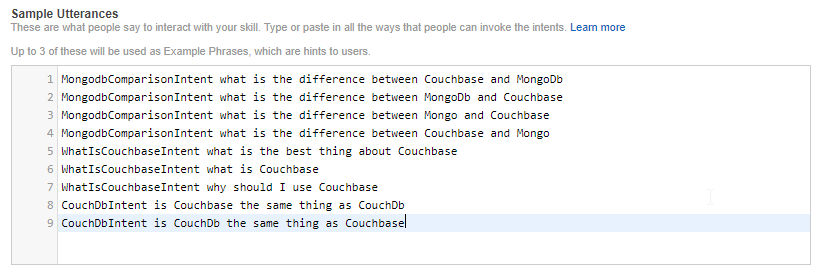
I’ve tried to think of all the different variations. But if I really wanted this to work more generally, I would setup parameters so that a user could ask the question "What is the difference between Couchbase and {x}".
Echo Dot in action
I did not publish this on the Alexa store. I did deploy it as a "beta test", so if you want to try it out, I’d be happy to send you an invitation to get it.
Here’s a video of my trying it out on my Echo Dot (which was a speaker gift last year from the fine people at DevNexus):
Will this actually work at a noisy booth? Well, let’s just say I’m not ready to bring an easy chair and pillow to the booth just yet. But it’s a fun way to demonstrate the power of Couchbase as an engagement database.
Summary
Alexa skills are a great place to use serverless architecture like Azure Functions. The skills will be used intermittently, and Azure Functions will only bill you for the time they are executed.
Couchbase Server again makes a great database for such an app. It can start out small to handle a single booth, but it can scale easily to accommodate larger demand.
Have a question about Couchbase? Visit the Couchbase forums.
Have a question for me? Find me on Twitter @mgroves.
Be sure to check out all the great documentation from Microsoft on Azure Functions, and the documentation on the Alexa Skills .NET library.
Tim Wingfield is using lots of APIs. This episode is sponsored by Smartsheet.
Show Notes:
- FireEye
- Ruby on Rails
- REST: REpresentational State Transfer
- CRUD: Create, Read, Update, Delete
- HTTP Request Methods: PUT, POST, GET, PATCH, DELETE
Want to be on the next episode? You can! All you need is the willingness to talk about something technical.
Music is by Joe Ferg, check out more music on JoeFerg.com!


